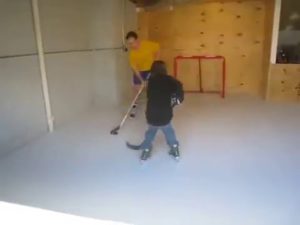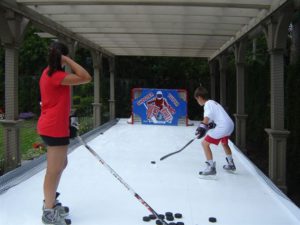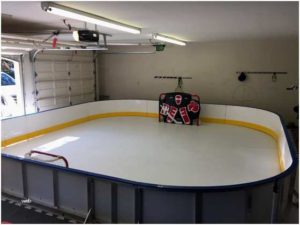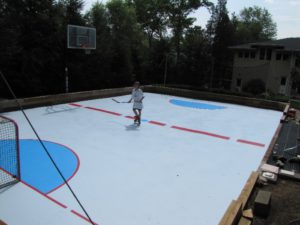Today I want to talk about synthetic ice for skating. In my last post I looked at a few different types of hockey shot pads, and one of those was the interlocking tiles. The cool thing is, there are different types of tiles that can be used for different things. While the previous post was focused on pads for shooting and stickhandling work, and the tiles I mentioned there are great for that type of training, there are other kinds of synthetic ice tiles that you can skate on as well.
The tiles for skating can be used for shooting and stickhandling practice too, of course, and virtually any other skill. So they really allow you to work on your entire game in an integrated way (with a couple caveats, which I’ll address).
There are always drawbacks, though. The skateable tiles are no exception, and I’ll discuss the downsides below too. Still, depending on the situation, the skating tiles can be an amazing way for a player to have fun, work on their skills, and make a huge developmental leap in their game.
How Do They Do That?
Let’s start by talking about the difference between the two categories of synthetic ice tiles. It’s pretty simple – the skateable tiles are made with a  different kind of plastic than the non-skateable tiles that I mentioned in my post about shot pads. The material in the skateable tiles is stronger and more resistant to impact, so it’s able to handle skate blades.
different kind of plastic than the non-skateable tiles that I mentioned in my post about shot pads. The material in the skateable tiles is stronger and more resistant to impact, so it’s able to handle skate blades.
One word of caution, though. Most skateable tiles are not designed to withstand toe picks, so figure skaters can do spins and edge jumps only. For hockey skates, there’s no issue.
There are also different types of skateable tiles. Some are infused with a lubricating agent that makes the surface slippery, while others aren’t and need to have a lubricant or “glide enhancer” applied every so often. The self-lubricating type has the obvious benefit of maintaining its glide factor. On the other hand, this type also can attract and show dust and dirt more easily.
Are You Feeling It?
Back in the day, synthetic ice was a really poor substitute for the real thing. There have been some major advances in the technology over the last few decades, though, to the point where lots of current and former professional players now have synthetic skating tiles at home – either to work on their own skills or for their kids, or both.
The main issue has always been that synthetic ice had a higher coefficient of friction than real ice. That’s basically a fancy way of saying that synthetic ice isn’t as slippery. When synthetic ice was first created, it had at least 30% more friction than real ice, which must have made skating on it about as easy as riding a bicycle on a sandy beach.
Modern-day synthetic ice is much better; it has 10-15% more friction than real ice. That’s certainly enough to notice a difference, but it’s not so  extreme that it is detrimental to a skater’s technique, or hard to get used to going from one surface type to the other.
extreme that it is detrimental to a skater’s technique, or hard to get used to going from one surface type to the other.
I should also mention that the 10-15% difference in friction between synthetic ice and real ice is based on a freshly-resurfaced sheet of real ice. As we all know, if real ice doesn’t get resurfaced regularly, it gets noticeably slower. So, if the measurement was taken on real ice after it had been skated on for a while, the difference in the coefficient of friction compared to synthetic ice probably would be even less than 10-15%.
Of course, that comes with the caveat that non-infused synthetic ice also could have increased friction if the glide-enhancing lubricant isn’t applied. Still, the lubricant doesn’t have to be applied nearly as often as real ice needs to be resurfaced. And with the infused tiles, skating on them doesn’t increase the friction level at all, it remains constant regardless of usage.
The slightly higher friction with synthetic ice compared to real ice does have some benefits. It forces skaters’ muscles to work just a tiny bit harder, so when players get back on real ice they are quicker and stronger on their skates. For beginning skaters, the higher friction makes it a little easier to maintain their balance and not have their feet fly out from under them.
Maintenance Mode
One perceived downside of synthetic skating tiles is the maintenance, so let’s take a look at that subject. As I said, the non-infused type of skating tiles need to have a glide-enhancing lubricant applied periodically. How often depends on how much the tiles are being used, but  rest assured that it wouldn’t even be close to a weekly task if the tiles were in a residential setting. And that brings up another point – the non-infused tiles are more common in non-residential settings (public rinks, training centers, etc.) than they are in private homes. That’s probably partly because the infused tiles offer no-additives-needed consistency regarding friction.
rest assured that it wouldn’t even be close to a weekly task if the tiles were in a residential setting. And that brings up another point – the non-infused tiles are more common in non-residential settings (public rinks, training centers, etc.) than they are in private homes. That’s probably partly because the infused tiles offer no-additives-needed consistency regarding friction.
Another drawback is that most synthetic tiles do produce some shavings, just like real ice. From everyone I’ve spoken with, it’s less than the amount of snow that would be produced by skating on real ice, but it’s worth mentioning. Cleaning up the shavings is straightforward – just sweep them up with a broom and put them in the trash.
Related to the shavings, skating tiles usually cause skate blades to dull faster than they would on real ice, so that means players skating on tiles need to sharpen their blades more frequently.
Finally, there’s the question of caring for the tiles. I mentioned above that the infused tiles can attract dust and dirt more quickly, but both types of tiles should be washed every so often with a mild soap and water. If infused tiles aren’t cleaned often enough, they can develop darker “grout lines” along the panel seams.
Crunching The Numbers
As you might expect, synthetic skating tiles aren’t cheap. Prices vary based on the brand, the thickness of the tiles (this relates to the expected lifespan), and the total square footage purchased. However, for a small surface area of 128 square feet, the cost will be anywhere from $850 to  $1300. A larger surface area generally will have a lower cost per square foot, but of course it still will cost more overall.
$1300. A larger surface area generally will have a lower cost per square foot, but of course it still will cost more overall.
The cost is definitely a drawback, but for those who can swing it, synthetic ice may actually be a sensible expense. When you add up the costs of sticks and pucks sessions (especially for families with more than one player), plus the cost of gas getting to and from the rink for those sessions, the synthetic tiles start to look like a good investment.
At my local rink, which has two sheets of ice, sticks and pucks sessions cost $10, and can run anywhere from 1.5 to five hours. On a side note, I don’t know why they charge the same amount for a 1.5-hour session as for a session that’s two or three times longer, but that’s neither here nor there.
Anyway, let’s say that a family has two kids that go to sticks and pucks. Maybe one kid goes as often as they can, say 40 times a year, while the other goes less often, maybe 15 times a year. And about five times a year, one of their parents decides to join them. So that adds up to 60 admissions to sticks and pucks sessions over the course of a year, costing $600.
Next, let’s look at the cost of gas to get to all those sessions. Every case is going to be unique, but I’ll just use mine as an example. I live just over eight miles from the rink, so I’ll round down and put the round trip at 15 miles total. Obviously the price of gas fluctuates, but I’ll estimate gas at $2.50 per gallon. That’s quite a bit lower than current prices where I live, and lower than the national average, but I’d rather use a conservative estimate.
If we assume average gas mileage of 25 mpg, that means that gas for each round trip to the rink for sticks and pucks costs about $1.50. For a total of 40 round trips in a year (assuming the parent and kid who goes 15 times go to sessions that the other kid is already going to), that’s $60. Add that to the admissions costs and the total now stands at $660.
Now let’s think about how much extra money might be spent while at the rink for those sticks and pucks sessions. I’m talking about the bane of any hockey parent’s existence – the vending machines and snack bar. I’m going to add an additional $40 for those ancillary expenses, which brings the total to $700. I think the $40 probably is too low – with 40 trips, when just a Gatorade costs $2, I recognize that some families might spend much more – but again, I’d rather be conservative.
Skateable tiles have a lifespan of at least 3-5 years. Depending on the model, the lifespan can be up to 20+ years. For families that go to as many (or more) sticks and pucks sessions as the hypothetical one we used for the calculations, synthetic ice could make more sense. Sticks and pucks for that family will cost, on the conservative side, $2100 over three years. Depending on the brand and the thickness of the tiles, that would buy 240 square feet (or more) of skateable tiles. That is for tiles with at least a 5-7 year lifespan; for tiles with a 3-5 year lifespan, the footprint would be well over 300 square feet.
One other thing to keep in mind is that if a player is serious about their game and takes private lessons, there’s a good chance that they could have a coach come to their home and work with them on the synthetic ice there for a significantly lower price, since that eliminates the additional costs built into the pricing at a rink.
Related to that, having skateable tiles at home might even reduce or eliminate the need for private lessons. Think about that hypothetical family. Maybe one of the parents, or an older sibling, would like to get on the ice to help a kid, but they can’t do it at sticks and pucks because the session times conflict with their schedule. Or maybe the kid wants help, but they’d rather not be seen getting a “lesson” from a family member in front of other people at sticks and pucks. With synthetic ice at home, that problem is resolved. Of course, some kids don’t want to take pointers from a parent or sibling, no matter where they are, but some kids do.
Hockey Stop
I hope this post has been useful for you. I plan to delve into the topic of skateable synthetic ice tiles a little more in the future so I can highlight some of the key differences between brands. Please keep an eye out for that in another post.
Meanwhile, what do you think about synthetic ice? Have you ever skated on it, and if so, what was your experience like? If you haven’t skated on it, is it something that you’re interested in trying? Why or why not? I’m really interested to hear your comments and questions on this!

I never knew that you could buy synthetic skating tiles! I’m intrigued! My mom always talks about when she was a child living in Denver and they had an ice rink in the backyard. In this case, I think was a large, shallow tray type thing that you fill with water and let freeze. Talk about low-tech! This was in the early 60s, by the way. This product is amazing because it can be used all year round and how fun would it be to have it in your basement? Anyway, I digress…. I really liked your article and I learned a lot. Thanks!
Hey Virginia – That’s awesome that your mom had a backyard rink when she was growing up. I actually wrote about backyard rinks (with real ice) recently, you might enjoy that post too. And please check back for another post about synthetic ice in the future. Thanks for your comment!
I have been working on local sports club and maintaining hockey hall and outdoor ring and it was such of pleasure to keep ice as good condition as possible so school kids and high school hockey players were able to continue their seasons even in the summer and also not-so-rich people were able to enjoy it. However, I never knew that it’s possible to buy those synthetic skating tiles. Thanks for sharing this, I will take a further look at your website and other articles on it
Thanks for your comment, and I appreciate you checking out the rest of the site.
I recently attended a birthday party and I was awed to find kids ice skating on a hot Sunday afternoon. It then dawned on me that indeed, it is possible with synthetic ice. This is an amazing concept. The maintenance does not sound that tasking if all the proper consideration is put into place. Thank you for the suggestion of using skate-able tiles. I would really love to incorporate this in my home in the near future, or maybe as a business in my area. Very intriguing and great article!
Thank you Carol, I’m glad you enjoyed it.
Hi! I had no idea synthetic ice was a thing! What a fascinating article! I was wondering, is this something you would have to put in your basement or could you install it in your backyard and cover it up with a tarp or special cover when not in use?
I love this idea, I’m just curious where the rink could be installed. Thank you so much!
Hi Bonnie,
You could put it in a basement or garage, or outdoors. You just need to have a flat, rigid sub-floor, so if you put it outside, it would need to be on top of pavers, a concrete pad, a wood platform, etc. All the tiles that I have researched have UV protection, so they won’t be damaged by sunlight; it’s fine if they get wet from rain/snow too. A tarp would help keep leaves, animal droppings, etc. off the tiles, though, and hence reduce the amount of cleaning needed.
Thank you so much for introducing me to skatable tiles! I had no idea there was such a thing!
The tiles are pricey yes, but I agree, considering the cost per visit to the rink for my 3 boys, this investment could actually save me a whole lot of money. We’ve been wanting to hire a private coach for our boys for some time now. This might be the savings we’ve been looking for to make this happen.
I look forward to your future posts on the various types of skatable tiles. I will definitely need to do a lot more research on them before we decide on if these would be a good fit and if so which type would be most beneficial. Thanks again!
Hi Shan,
No problem, thank you! I’m glad this was a useful post for you, and please stay tuned for more info about the different options available.
We bought infused (self lubricanting) synthetic ice about a year and a half ago. We still put a very small amount of the glide enhancer on it about once every two months. Glide is everything. I would say we get about 60′ on one push. Not as good as real ice but pretty close and PLENTY good to skate and do drills on. I have skated on several other brands of synthetic ice with VERY poor glide. I was VERY afraid I was going to spend a lot of money and hate it. Even some brands that claimed to be self lubricanting. Also, all glide enhancers are not created equal. I definitely recommend ez glide enhancer. I swear I don’t work for them and have no connection to them. WARNING use VERY little and lightly run a towel over it after. The first time I did it I mist it on VERY lightly but did not run a towel over and thought it was awful. Was very oily. Called the company and complained. A nice lady explained try running a towel they sell behind it and most it VERY lightly. I just made own towel Zamboni. Worked awesome and not oily.
We probably skate on it two or three times a week. Usually myself and my two sons. During Covid we have been skating almost daily. My boys are AAA hockey players and love it. Ps. The brand of synthetic ice I have is not ez glide. Just liked the addition of their enhancer. It also really helped keep the shaving WAY down. Just have to be sure to get it on right. People will tell you synthetic ice is bad but if you buy the better stuff and maintain it right you will love it. We have a 20’x40′ rink in our basement and I still laugh everytime we go down put on the skates and just skate around down there playing hockey. Still seems surreal.
Bob,
Thanks for sharing all this, it’s great info and I’m sure other readers here will appreciate it. Sounds like you’ve got a great setup in your basement. If you don’t mind me asking, what brand of tiles do you have?
Thanks again,
Jordan
HI Jordan, Did Bob H ever tell you what brand of tiles he is using? He seemed to have tried several and liked the one he had. His only clues were self lubricating and not ez glide although her uses their enhancer. When it comes to tiles is thicker better?
THANKS
Carol K.
Hi Carol,
No, unfortunately I didn’t hear back from Bob about which brand of tiles he has. I would love to know too.
As far as tile thickness, it’s not that thicker is better in terms of the glide factor, but when compared against a thinner option of the same type and brand, thicker tiles will have a longer lifespan. They’ll also be more expensive, but might turn out to be more economical in the long run. Think of it like car tires. If tire A lasts 30K miles and costs $100, and tire B lasts 50K miles and costs $125, tire B is more expensive up front, but is a better value. The thing with the tiles is that the lifespan is really determined by how much use they get, the companies estimate the lifespan in years based on an assumption of usage level.
Thanks for your question, and please check back for more about synthetic skating tiles in the future. I’d like to do reviews of different brands (like I did with my post on HockeyShot tiles), but before writing about a given brand of tiles, I want to skate on them myself first.
Does anyone know where to buy EZglider in UK? Thanks
Hi Loretta,
Thanks for asking. I assume you’re talking about EZ Glide tiles, right? Or are you talking about the glide-enhancing lubricant? For the tiles (and maybe the glide enhancer too), off the top of my head I would suggest trying Amazon, but let me look into it and I’ll try to have more info for you after the weekend.
Jordan